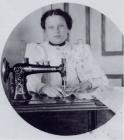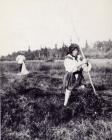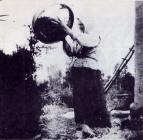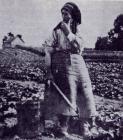1
The article by Hannah Polowy tells about the role of the Ukrainian pioneer woman in family life.The Role of the Pioneer Woman in Family Life
In the first decades of large-scale settlement in Canada, the first Ukrainian settlers met the challenge of a strange land on the prairie wilderness.
The isolation and influences of this rural environment, together with the hostility of the host society in those early years, shaped the Ukrainian settlements along the lines of their own culture and customs. The women of the community had a considerable role in this within their family and life style of the group. It is interesting to note that as late as 1961, some sixty percent of the ethnic group still used Ukrainian as their main language, married within their own group, and maintained a highly viable cultural identity. This was the situation even though seventy-five percent of the group was already native born.
The role of the Ukrainian woman who arrived in Canada some hundred years ago was that of wife, mother and worker. She rarely worked outside the home because she cleared homesteads, worked in the fields, tended the garden, watered and fed the cattle, reared children and participated in some aspects of community life.
If a woman was married in the old country, prior to emigration to Canada, the union was generally founded upon the best economic base. !f a young woman married soon after her arrival in Canada, this custom still prevailed. Of course, her social role changed with the marriage ceremony and this affected her activities as well as her personality. A new role went with her marriage ceremony as she became her husband's helper and attendant.
It was the woman's responsibility to rear children. This has proven to be a most significant and influential factor in preserving the language, traditions and identity within the community in the early period of establishing themselves in the new land. Because the menfolk worked away from home during the early years of settlement, the mother was the important adult in the family.
She was not aware of, nor familiar with the customs of others, and reared her children in the ways and traditions of her own upbringing in the old country. She used the language, songs, stories which were told to her as a child. She celebrated holidays, cooked Ukrainian dishes, and set the moral and disciplinary learning in terms of the life style with which she was familiar. Because of the very nature of the rural settlements and urban groupings, much of the life style was reinforced outside the family in a group situation. Thus, the children of our pioneers were steeped in the traditions, customs, and values of their parents.
The preservation of the Ukrainian language within the community, to a large degree, was due to the role of the women in the home and community. It was the mother in the Ukrainian community who devoted the most time to the upbringing of the children, and who was responsible for the vitality of the Ukrainian language in successive generations. The pioneer woman was unfamiliar with the English language and was not exposed to its needs and usage in her constrained life on the homestead and in the immediate language community. She did not have the mobility of the husband who sought and worked on seasonal jobs, and who had dealings in the market place. So, it was natural and important for her, as the concerned and constant figure in the life of her children, to use and retain her own language within the family. There was little need for her, in her circumstances, to learn and use the English language.
The question of language became a matter of concern for the parents and the community group once the children began to acquire and use the language of the public school and their own peers, and to become assimilated in the language and life style of the host society. Organizations, church societies and others established Ukrainian language schools to meet the problem and the challenge of these pressures. This problem has grown more acute with each new generation and remains to this day. That it is a key to important cultural values in the development of Canadian society, as a significant element within it, is slowly being recognized in the establishment of language study in the school curricula of the prairie provinces, and as credit subjects in the universities of Alberta, Saskatchewan, Manitoba, Toronto and Ottawa.
The Ukrainian immigrants, from the very beginning, wanted a larger role for their children than the one that history had consigned to them. They placed a high value on education for their children. This was often frustrated, in those days, by their own economic circumstances. This was true of the twenties and thirties. The impact of World War II brought many changes in its wake, with new directions and a high degree of mobility as a consequence. Many Ukrainian women went into white-collar jobs - as office workers, sales clerks, teachers, nurses, and so on. The teaching profession particularly attracted the young women as it provided an opportunity to improve their social and economic status more quickly. In this last decade, more Ukrainian Canadians have entered the professions so that one can assume that this includes women as well.
The growing trend to the urban centres, accelerated by the technological revolution, has plunged whole families into a new way of life. Life patterns and life styles have drastically changed - in society as a whole, within the cultural community, and within the family.
"The Ukrainian Canadian" magazine, May 1974, p.68-69, Kobzar Publishing Company Limited
6
Mr. and Mrs. Chahley, owners of a livery barnEarly 1900s
Smoky Lake, Alberta, Canada
 Credits:
Credits:Provincial Archives of Alberta








